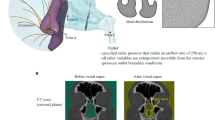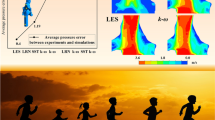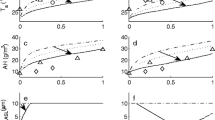Abstract
Warming, filtering, and humidification of inspired air are major functions of the upper airway, which can be negatively altered by local disorders or surgical interventions. These functions have not been described in neonates because of ethical and technical problems difficult to solve. Numerical simulations can get around these limitations. The objective of this study was to analyze physiological nasal airflow and thermal distribution using computational fluid dynamics (CFD) techniques in neonates. CT imaging of neonates was collected from the Pediatric Radiology Department of our center. CFD has been used to simulate nasal airflow numerically, with ambient air set at 19 °C, following the recommendations for a neonate’s bedroom. Thermal distribution within the nasal cavity was analyzed and coupled with airflow patterns over complete respiratory cycles. Sixteen patients have been included in the study. During inspiration, important air warming is noticed in the first centimeter of the nasal cavity (+ 8 °C at the anterior end of the inferior turbinate). During the expiration phase, the temperature decreases slightly (− 3 °C) between the pharynx and the nostrils. A model with asymmetric nasal fossae showed that nasal obstruction leads to decreased airflow and abnormally high temperatures in the obstructed side (+ 2 °C at the nasal valve, + 4 °C at the choana). According to our results, the nasal valve area is of crucial importance in air warming in neonates, when ambient air is 19 °C, since about 70% of air warming is performed in this area. When needed, surgical interventions should respect the anatomy of this zone and restore normal airflows and warming.

.










Similar content being viewed by others
References
Keck T, Leiacker R, Heinrich A, Kuhnemann S, Rettinger G (2000) Humidity and temperature profile in the nasal cavity. Rhinology 38(4):167–171
Keck T, Leiacker R, Riechelmann H, Rettinger G (2000) Temperature profile in the nasal cavity. Laryngoscope 110(4):651–654. https://doi.org/10.1097/00005537-200004000-00021
Sommer F, Kroger R, Lindemann J (2012) Numerical simulation of humidification and heating during inspiration within an adult nose. Rhinology 50(2):157–164. https://doi.org/10.4193/Rhino11.231
Hanida S, Mori F, Kumahata K, Watanabe M, Ishikawa S, Matsusawa T (2013) Inflence of latent heat in the nasal cavity. J Biomech Sci Eng 8(3):209–220. https://doi.org/10.1299/jbse.8.209
Zhao K, Jiang J, Blacker K, Lyman B, Dalton P, Cowart BJ et al (2014) Regional peak mucosal cooling predicts the perception of nasal patency. Laryngoscope 124(3):589–595. https://doi.org/10.1002/lary.24265
Sozansky J, Houser SM (2014) The physiological mechanism for sensing nasal airflow: a literature review. Int Forum Allergy Rhinol 4(10):834–838. https://doi.org/10.1002/alr.21368
Li C, Farag AA, Leach J, Deshpande B, Jacobowitz A, Kim K, Otto BA, Zhao K (2017) Computational fluid dynamics and trigeminal sensory examinations of empty nose syndrome patients. Laryngoscope 127(6):E176–E184. https://doi.org/10.1002/lary.26530
Sullivan CD, Garcia GJ, Frank-Ito DO, Kimbell JS, Rhee JS (2014) Perception of better nasal patency correlates with increased mucosal cooling after surgery for nasal obstruction. Otolaryngol Head Neck Surg 150(1):139–147. https://doi.org/10.1177/0194599813509776
Kimbell JS, Frank DO, Laud P, Garcia GJ, Rhee JS (2013) Changes in nasal airflow and heat transfer correlate with symptom improvement after surgery for nasal obstruction. J Biomech 46(15):2634–2643. https://doi.org/10.1016/j.jbiomech.2013.08.007
Dayal A, Rhee JS, Garcia GJ (2016) Impact of middle versus inferior total turbinectomy on nasal aerodynamics. Otolaryngol Head Neck Surg 155(3):518–525. https://doi.org/10.1177/0194599816644915
Moreddu E, Le Treut-Gay C, Triglia JM, Nicollas R (2016) Congenital nasal pyriform aperture stenosis: elaboration of a management algorithm from 25 years of experience. Int J Pediatr Otorhinolaryngol 83:7–11. https://doi.org/10.1016/j.ijporl.2016.01.011
Moreddu E, Pereira J, Vaz R, Lena G, Triglia JM, Nicollas R (2015) Combined endonasal and neurosurgical resection of a congenital teratoma with pharyngeal, intracranial and orbital extension: case report, surgical technique and review of the literature. Int J Pediatr Otorhinolaryngol 79(12):1991–1994. https://doi.org/10.1016/j.ijporl.2015.10.056
Ghoneima A, AlBarakati S, Jiang F, Kula K, Wasfy T (2015) Computational fluid dynamics analysis of the upper airway after rapid maxillary expansion: a case report. Prog Orthod 16:10. https://doi.org/10.1186/s40510-015-0085-x
Luo H, Sin S, McDonough JM, Isasi CR, Arens R, Wootton DM (2014) Computational fluid dynamics endpoints for assessment of adenotonsillectomy outcome in obese children with obstructive sleep apnea syndrome. J Biomech 47(10):2498–2503. https://doi.org/10.1016/j.jbiomech.2014.03.023
Persak SC, Sin S, McDonough JM, Arens R, Wootton DM (2011) Noninvasive estimation of pharyngeal airway resistance and compliance in children based on volume-gated dynamic MRI and computational fluid dynamics. J Appl Physiol (1985) 111(6):1819–1827. https://doi.org/10.1152/japplphysiol.01230.2010
Landau LD, Lifshitz EM (2013) Fluid mechanics. Elsevier Science, Amsterdam
Mimouni-Benabu O, Meister L, Giordano J, Fayoux P, Loundon N, Triglia JM et al (2012) A preliminary study of computer assisted evaluation of congenital tracheal stenosis: a new tool for surgical decision-making. Int J Pediatr Otorhinolaryngol 76(11):1552–1557. https://doi.org/10.1016/j.ijporl.2012.07.009
Moreddu E, Meister L, Philip-Alliez C, Triglia JM, Medale M, Nicollas R (2018) Computational fluid dynamics in the assessment of nasal obstruction in children. Eur Ann Otorhinolaryngol Head Neck Dis
Lindemann J, Leiacker R, Rettinger G, Keck T (2002) Nasal mucosal temperature during respiration. Clin Otolaryngol Allied Sci 27(3):135–139
Naftali S, Rosenfeld M, Wolf M, Elad D (2005) The air-conditioning capacity of the human nose. Ann Biomed Eng 33(4):545–553
Pless D, Keck T, Wiesmiller K, Rettinger G, Aschoff AJ, Fleiter TR, Lindemann J (2004) Numerical simulation of air temperature and airflow patterns in the human nose during expiration. Clin Otolaryngol Allied Sci 29(6):642–647. https://doi.org/10.1111/j.1365-2273.2004.00862.x
Lintermann A, Meinke M, Schroder W (2013) Fluid mechanics based classification of the respiratory efficiency of several nasal cavities. Comput Biol Med 43(11):1833–1852. https://doi.org/10.1016/j.compbiomed.2013.09.003
Wang DY, Lee HP, Gordon BR (2012) Impacts of fluid dynamics simulation in study of nasal airflow physiology and pathophysiology in realistic human three-dimensional nose models. Clin Exp Otorhinolaryngol 5(4):181–187. https://doi.org/10.3342/ceo.2012.5.4.181
Avery ME, Normand C (1965) Respiratory physiology in the newborn infant. Anesthesiology 26:510–521. https://doi.org/10.1097/00000542-196507000-00015
Wiesmiller K, Keck T, Leiacker R, Lindemann J (2007) Simultaneous in vivo measurements of intranasal air and mucosal temperature. Eur Arch Otorhinolaryngol 264(6):615–619. https://doi.org/10.1007/s00405-006-0232-6
Liener K, Leiacker R, Lindemann J, Rettinger G, Keck T (2003) Nasal mucosal temperature after exposure to cold, dry air and hot, humid air. Acta Otolaryngol 123(7):851–856
Author information
Authors and Affiliations
Corresponding author
Ethics declarations
Conflict of interest
The authors declare that they have no conflict of interest.
Ethical approval
According to French law, ethical approval was not needed for this kind of research. This study was conducted in accordance with the Declaration of Helsinki and French Good Clinical Practices.
Additional information
Publisher’s note
Springer Nature remains neutral with regard to jurisdictional claims in published maps and institutional affiliations.
Rights and permissions
About this article
Cite this article
Moreddu, E., Meister, L., Dabadie, A. et al. Numerical simulation of nasal airflows and thermal air modification in newborns. Med Biol Eng Comput 58, 307–317 (2020). https://doi.org/10.1007/s11517-019-02092-w
Received:
Accepted:
Published:
Issue Date:
DOI: https://doi.org/10.1007/s11517-019-02092-w




